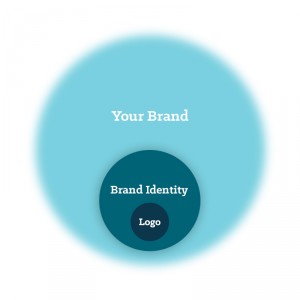Think about your favourite or most unforgettable logos. Whether it’s the Nike swoosh or “I Love NY”, we know logos are important because we remember them and begin to identify with them over time. For destinations, new marketing is about making connections with those specific people who might be interested in exactly what your destination has to offer. But how does a logo fit into a brand and how does it help your destination connect with residents and visitors?
A logo is a symbol that represents your destination, but it is not your brand. It is one result of an important brand strategy process that seeks to uncover the destination’s identity.
A logo is a tiny piece of a destination’s brand
This basic diagram helps illustrate the difference between brand, brand identity and logo:
 Your logo is the symbol that represents your city, place, or destination.
Your logo is the symbol that represents your city, place, or destination.
It can include images, words, typography and colour. Logos are often paired with a slogan or tagline, such as Limburg’s “Liefde voor het leven” (translated as “Lust for life”). A logo should be one visual element resulting from a comprehensive branding process, not the objective.
Brand identity is what you do with the logo.
This involves how the logo is expressed in messaging and throughout your destination through design, written and visual elements. This includes anything from the logo’s placement on letterhead, to branded colours on your visitor centre, to the tone of voice and keywords used in promotional material. This identity can be spread throughout your destination in many mediums. For example, buses in the Polish city of Łódź are painted in exactly the same color as the city’s logo. Holland’s distinctive orange logo colour permeates the region, popping up at festival booths and on advertising.
Your brand is a holistic picture of your destination or place.
It includes your strategy, messaging, content, storytelling, customer service, visitor and resident experiences that are all tied to your destination’s unique DNA. Its combination of DNA elements (culture, environment, attractions, customs, and much more) form the “terroir” of your destination, which is its sense of place.
Your destination’s marketing (which includes both promotion and product), comes from understanding this DNA. The result should be balanced, it should be authentic and it should not lie. It should not try to sell something it cannot deliver.
Are you creating a new logo?
A successful logo should be tested in the market before it is chosen. This means consulting with both residents and visitors to ask their opinion. Does the logo connect with them?
Above all, a logo needs to create an emotional response aligned with your destination DNA. Some great examples of this include the ubiquitous “I Love New York” and “I amsterdam”. These logos evoke emotion by emphasizing the relationship between the visitor and the destination and expressing the pride residents feel for being from those places.

Image credit: Melanie Feuerer, Flickr
Destination marketers need to seek these kinds of connections throughout the branding process, of which a logo is only a small part.
If you change your logo, it won’t have any impact on your destination’s brand. Change your brand, however, and you might have to adapt your logo. Changing a logo requires a large effort, so it should not be done simply for aesthetic reasons, for appearing “ugly” or “old-fashioned.” A logo change can be one outcome of the branding process, but it cannot be the starting point.
Are you developing your brand strategy? Destination Think has helped many destinations as a unique partner through workshops and consultation. To learn how to identify your destination’s Place DNA® and refine your destination’s brand, contact us today.









Thanks, Frank for churning the pot with one of the most, and most often misconstrued elements of destination marketing – the logo vs. the brand. Informing and educating both DMO teams and the community/general public about the critical distinctions is an ongoing challenge. In many cases, ignorance is the norm, while uneducated teams of marketeers on committees, etc. make ‘marketing’ decisions about the destination. Further clouding and dissolution of the destination’s identity is often the result. – Eric
Thank you Eric. You are right. We often see a ‘bad lasagne’ of layers of visuals, messages and identities….